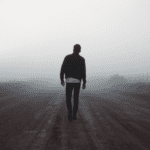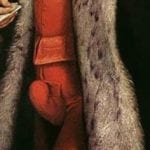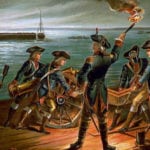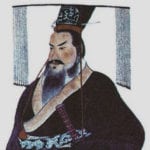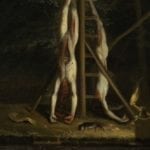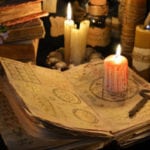 Technology
Technology  Technology
Technology  Humans
Humans 10 Everyday Human Behaviors That Are Actually Survival Instincts
 Animals
Animals 10 Animals That Humiliated and Harmed Historical Leaders
 History
History 10 Most Influential Protests in Modern History
 Creepy
Creepy 10 More Representations of Death from Myth, Legend, and Folktale
 Technology
Technology 10 Scientific Breakthroughs of 2025 That’ll Change Everything
 Our World
Our World 10 Ways Icelandic Culture Makes Other Countries Look Boring
 Misconceptions
Misconceptions 10 Common Misconceptions About the Victorian Era
 Mysteries
Mysteries 10 Strange Unexplained Mysteries of 2025
 Miscellaneous
Miscellaneous 10 of History’s Most Bell-Ringing Finishing Moves
 Technology
Technology Top 10 Everyday Tech Buzzwords That Hide a Darker Past
 Humans
Humans 10 Everyday Human Behaviors That Are Actually Survival Instincts
 Animals
Animals 10 Animals That Humiliated and Harmed Historical Leaders
Who's Behind Listverse?

Jamie Frater
Head Editor
Jamie founded Listverse due to an insatiable desire to share fascinating, obscure, and bizarre facts. He has been a guest speaker on numerous national radio and television stations and is a five time published author.
More About Us History
History 10 Most Influential Protests in Modern History
 Creepy
Creepy 10 More Representations of Death from Myth, Legend, and Folktale
 Technology
Technology 10 Scientific Breakthroughs of 2025 That’ll Change Everything
 Our World
Our World 10 Ways Icelandic Culture Makes Other Countries Look Boring
 Misconceptions
Misconceptions 10 Common Misconceptions About the Victorian Era
 Mysteries
Mysteries 10 Strange Unexplained Mysteries of 2025
 Miscellaneous
Miscellaneous 10 of History’s Most Bell-Ringing Finishing Moves
10 Utterly Bizarre Riots Throughout History
Throughout history, many riots have stemmed from discrimination, societal and political differences, poverty, sports, and drunkenness, just to name a few causes. But other times, strange events spark a clash involving unusual groups of people. These clashes escalate to levels where they turn destructive and even deadly, leading to the most unusual riots in history.
10Disco Demolition Night
In the late 1970s, disco had a sizable number of vocal and venomous detractors. One notable critic of the genre was Chicago rock radio DJ Steve Dahl, who became popular for his “Disco Sucks” stance. Knowing that Dahl was popular and people genuinely didn’t like disco, the son of the owner of the Chicago White Sox, Mike Veeck, thought that it would be a good promotional idea to host a Disco Sucks night. On July 12, 1979, Dahl’s listeners could get into the doubleheader against the Detroit Tigers for 98 cents. They were also required to bring a disco record with them because Dahl was going to blow up a pile of disco records.
Veeck didn’t think the promotion would be that popular, so he hired enough security to handle about 35,000 people. But Veeck underestimated people’s hatred of disco. Over 60,000 people showed up. Some even brought ladders and climbed fences to get in.
During the first game, the crowd seemed rowdy. The Tigers won, but that wasn’t the spark that set everything off. That happened when Dahl blew up the records as planned. After the explosion, people poured out onto the field and started trashing the stadium. Both Dahl and Veeck tried to calm the crowd, but they failed. The rioters literally stole bases, tore apart batting cages, and set fire to banners.
Amazingly, during the riot, only one person was hurt: a vendor who broke his hip. Despite it being a destructive riot, it was relatively peaceful. Veeck believed this was due to the marijuana that people were smoking. He compared it to the much more violent beer promotion in 1974 in Cleveland, where they sold beer for 10 cents a cup. That somehow got out of hand.
In total, 39 people were arrested for the Disco Sucks riot. Veeck considered the promotion a success because people still remember it 30 years later.
9The Great Police Riot

When a riot breaks out, the first people who respond are usually the police. But what happens when the police are the ones doing the rioting, as on June 16, 1857, in New York City?
In 1857, the mayor of New York was Fernando Wood, and he was notoriously corrupt. The state was run by the Republicans, Wood was a Democrat, and the Republicans were looking to exert more power over the city. To deal with both issues, the state passed a bill that created the Metropolitan Police Force, and they would have police authority over New York City, Staten Island, Brooklyn, and Williamsburg. Mayor Wood didn’t like the ruling and refused to disband the Municipal Police Force. So during the spring of 1857, there were two police forces roaming the streets of New York. It was only a matter of time before the two forces clashed.
In June, things heated up when police officers confiscated criminals whom the other police force had arrested. Things took a more violent turn on June 16, when the Metropolitan Police Force tried to arrest Mayor Wood at City Hall. A riot between 800 Municipal and 50 Metropolis police officers erupted, and there were fights in the hallways and in front of City Hall. More than 50 people were injured in the riot.
On July 2, Mayor Wood finally disbanded the Municipal Police Force. The Supreme Court of New York ruled that the Metropolitan Police Force had police jurisdiction over New York City, and they sent the militia to back them up. Two days after the police were disbanded, the famous Dead Rabbits riots, which were depicted in Martin Scorsese’s Gangs of New York, broke out in the Five Points.
8The Old Price Riots

In December 1808, a fire broke out in the Covent Garden Theatre in London. It destroyed the building and many of the costumes inside of it.
The owner of the theater set to work to rebuild. The construction and buying new costumes was costly, so when the new theater was set to open nine months after the fire, the manager, John Philip Kemble, increased the prices slightly. For example, one section had a price increase from six shillings to seven shillings.
The riots started on the opening night, which was Macbeth, with Kemble playing the main role. People made noise, banging pans. The protests, which consisted of several riots, lasted two months. Furthering the problems, the owner of the theater hired boxers as enforcers, which only escalated the violence.
The riot finally came to an end when Kemble agreed to lower the prices and apologized for raising the prices and hiring the boxers.
7The Lincoln Prison Riot Of 2002

Prison is a dangerous place, and prison riots are a sad inevitability when a group of dangerous individuals are locked up with very little to do with their abundance of time. What is surprising is what set off one of the worst prison riots in England in the past 20 years.
On October 23, 2002, the prisoners found out that instead of being served a hot lunch, they would be served sandwiches instead. Upset at the change in the menu, a group of inmates overpowered a guard and stole his keys. With the keys, they opened the cells and released more prisoners, overrunning the prison. It took 550 prison and police officers eight hours to control the riot that was sparked by sandwiches. The riot cost £3 million, 35 people were injured, and one prisoner died from a drug overdose. Six inmates received nine-year sentences for their roles in the riot.
Amazingly, this was not the only time a prison riot stemmed from an incident over a sandwich. A riot that led to 11 inmates and one correctional officer being injured happened in August 2013 at Riker’s Island. One gang member wanted to make a grilled cheese, but needed a hot plate to do so. Another gang had the hot plate and refused to share, and the riot broke out.
6The Leicester Balloon Riot

In 1862, British aeronaut Henry Coxwell and meteorologist James Glaisher used a hot air balloon to climb to the stratosphere to see what would happen. The trip was almost disastrous: Glaisher passed out, and Coxwell had to open the valve cord to lower the balloon with his teeth. Yet they both survived the trip, making them the first people to make it to the stratosphere, and it made Coxwell a celebrity.
Two years later, on July 11, 1864, Coxwell was scheduled to appear at the Order of Forester’s fete in Leicester, United Kingdom, with his biggest and newest balloon, The Britannia. While he was setting up for his launch, a man in the crowd of 50,000 spread a rumor that the balloon was not, in fact, Coxwell’s biggest and newest. People became impatient, so they broke into Coxwell’s preparation area and demanded he take off soon. People who had bought tickets to take a ride were also becoming impatient and rude. Due to the rush of people, the balloon and basket were damaged. Coxwell told people to give him space, and when they didn’t, he started to deflate the balloon.
People there to see the hot air balloon weren’t happy to see it deflated. They set about trashing the balloon, cutting it up and then setting the basket on fire. The rioters also set upon Coxwell, who was miraculously led away to safety by one of the few policemen on site. Unluckily, a man was mistaken for Wilcox, and his coat was torn apart. Members of the crowd tried to sell pieces of the balloon as souvenirs, while others picked up the balloon and marched it through the town, passing the home where Coxwell was in hiding.
The riot was condemned by The London Review of Politics, Society, Literature, Art and Science and by Coxwell himself. Coxwell called the townspeople savages, while the townspeople blamed out-of-towners for the riot.
5The University Of Paris Riot

On March 6, 1229, which was Shrove Tuesday (also known as Mardi Gras), the students of the University of Paris were celebrating at a tavern. At the end of the evening, there was a disagreement about the bill. The students started brawling, which led to them being beaten up and thrown out of the tavern. The next day, Ash Wednesday, a large group of students returned to the tavern and broke in. They beat the owner and set the tavern on fire. Then they poured out onto the street and continued to riot, destroying a few more shops before the riot was broken up.
At the time, students at the University of Paris studied theology, so they were under protection of the Catholic Church and were not subject the laws of the king of France. That rule didn’t sit well with the citizens of Paris, so they pressured the king to punish the students. The king relented and allowed his soldiers to raid the students’ residences, and a few students were killed by the heavy-handed guards.
The masters at the school demanded retribution from the king for the raid, and when they didn’t get it, they went on strike. The strike went on for another two years, and it only came to an end when the pope, who had been educated at the university, intervened and issued a papal bull. It was called “Parens Scientiarum” (“Mother of all Sciences”), and it confirmed that the university was only bound by the laws of the Church. After it was issued, the masters returned to teaching.
4The Boston Massacre

One of the most pivotal moments in the American Revolution was the Boston Massacre on March 5, 1770. While the event itself was not unusual in terms of a riot, this history-changing event started in a rather small and seemingly insignificant way.
Apparently, the riot started when apprentice wig-maker Edward Gerrish saw British Captain Lieutenant John Goldfinch and started harassing him for not paying his debt to the wig-maker. From behind, another British soldier hit Gerrish and knocked him down. Gerrish went and got his friends and surrounded the Custom’s House in Boston that was being guarded by the British. They started throwing snowballs at the soldiers, who responded by shooting five people dead and injuring another six.
Patriots like Paul Revere and Samuel Adams would use the story of the Boston Massacre to inspire people to fight the American Revolution. And it all started over an argument over a debt for a wig.
3The Keene Pumpkin Fest Riot
There are some places that seem like potential powder kegs for riots, like massive sporting events, political protests, and Guns N’ Roses concerts, but a pumpkin festival in Keene, New Hampshire? Oddly enough, that is exactly where a riot sprang in October 2014.
The Keene Pumpkin Festival, which is held annually near Keene State University, is usually a pretty tame event. However, on October 18, 2014, things got out of hand due to partying students. A car was overturned, and fights ensued. SWAT teams with nonlethal weapons, including paintball pellets filled with pepper spray and sponge bullets, descended on the Pumpkin Fest rioters. In response to the police presence, the rioters threw liquor bottles, and apparently, they were throwing billiard balls as well. In total, the Pumpkin Festival riot lasted for 12 hours, 30 people were hurt, and dozens were arrested. The city blamed the riot on the college students and out-of-towners.
What is interesting about Keene, New Hampshire, is that it had previously made national headlines when it applied for and received a BearCat mine-resistant armored vehicle in the wake of 9/11. The police force had said that the reason Keene, which has less than 25,000 people, needed a tank-like vehicle was because the Pumpkin Festival was a possible terrorist target. Since making the headlines, the city had become a symbol for the militarization of police forces in the United States. It is also believed that their response could have aided in escalating the riot.
2The New York Doctors Riot

In the late 18th century in New York City, there were no rules or regulations for how bodies were collected for practice autopsies for medical students. This didn’t sit well with many people, because the idea of cutting up dead bodies was already creepy enough to the common citizen. The atmosphere was only made worse when rumors arose that students were stealing bodies from graveyards. Fear and anger over those rumors finally erupted on April 16, 1788.
There are various accounts as to what started the riot, but all the stories revolve around a severed arm and a group of boys playing outside the New York Hospital. In one version, they saw an arm hanging out of a window to dry. In another version, they were climbing a ladder and looked into a window. A medical student waved at them using the severed arm. In the final telling of the story, one of the boys saw the arm, and the medical student told him it was from his recently deceased mother. Also, in this version, the boy ran home and told what he saw to his father, a mason. The boy’s father then went to the cemetery and dug up his wife’s coffin to find it empty. He led the angry mob to the hospital.
When the mob descended on the hospital, a lot of the staff and the medical students ran, but a few stayed behind to protect the specimens. Apparently, after the mob broke into the hospital, they found three fresh bodies, and one was being boiled. There were also male and female body parts hanging up. Disgusted by what they found, the rioters dragged the specimens into the street and set them on fire.
The mayor and the sheriff arrived on scene, and any remaining hospital staff was brought to the jail for their own protection. The crowd dispersed, but the rioters were far from settled. The next morning, they set out to look for more bodies. Hundreds of people gathered around Columbia University before forcing themselves in. The bodies had been removed the night before, so none could be found. Then people started invading the houses of the doctors, looking for more bodies, but again, none were found.
Frustrated, a group of around 5,000 people armed with bricks, rocks, and timber descended on the jail where the doctors were hiding and demanded they be brought out. When someone tried to break into the jail, he was killed by a guard, and that only made the crowd angrier. Militiamen were brought in but were told not to fire their muskets. That was until Secretary of Foreign Affairs John Jay (soon to be the first Chief Justice of the Supreme Court) was hit in the head with a rock and Revolutionary War hero General Baron von Steuben was struck with a brick. The militia opened fire on the crowd. Three rioters and three militiamen died, and perhaps 20 people died in total.
After the riot, laws were enacted to ensure that cadavers were legally collected, and harsher penalties were put in place for grave robbing. Oddly enough, this wasn’t the only riot that stemmed from cadavers. In fact, between 1765 and 1854, in New Haven, Baltimore, Cleveland, and Philadelphia, there were 17 similar incidents.
1The Toronto Clown And Firefighter Riot

In July 1855, a traveling show called S.B. Howes’ Star Troupe Menagerie & Circus stopped in Toronto, Ontario, for shows over a couple of days. On the night of July 12, several clowns went to a tavern that was rumored to be a brothel. The tavern was also a hangout for a volunteer firefighter brigade, the Hook & Ladder Firefighting Company.
Both groups were full of rough-and-tumble men; the clowns with the show were the men who set up and took down the circus tent, while the firefighters had a reputation for brawling. At some point in the night, there was a disagreement between the two groups. One version of the story says that a clown cut in line, another story says that a hat was accidentally knocked off the head of the boss clown. Regardless of how it started, a brawl broke out, and two firefighters were badly injured. The fire brigade retreated, and the clowns were victorious that day.
At that time in Toronto, a fraternal organization called the Orange Order was made up of Protestants. The organization ensured that Orangemen received jobs, so a lot of firefighters and police officers were Orangemen. Word of the fight spread through the ranks of the Orange Order, and the next day, several showed up to confront the circus performers. When members of the Hook and Ladder showed up, mayhem broke out. All the tents, including the big top, were pulled down and set on fire. Wagons were overturned and destroyed. The clowns were also mercilessly beaten.
The chief of police, who was also an Orangeman, took his time sending out officers to help, and when they did arrive on the scene, the officers didn’t do much to help the circus; they simply watched the destruction and the beatings. The riot only stopped when the mayor showed up. He personally pulled an axe out of the hands of a firefighter who planned on killing a clown with it. The militia had to be called in, and the circus folk were allowed to grab their belongings that weren’t destroyed.
The riot was one of the major events that led to police reform in the city of Toronto.
Robert Grimminck is a Canadian freelance writer. You can friend him on Facebook, follow him on Twitter or on Pinterest, and visit his website.

